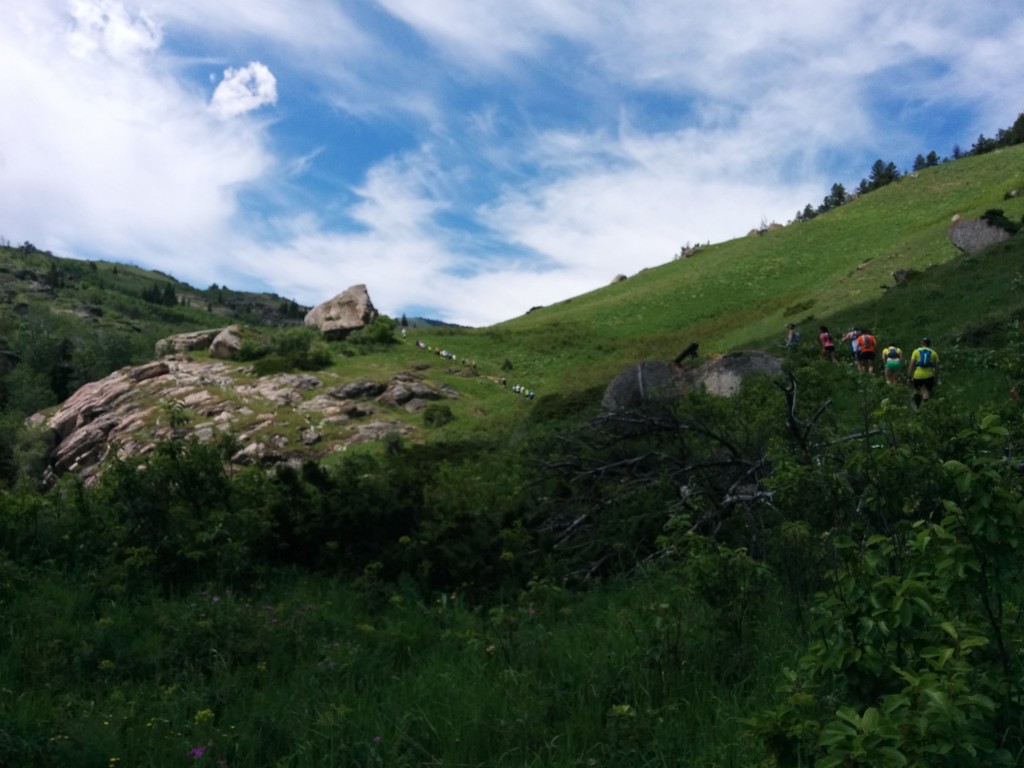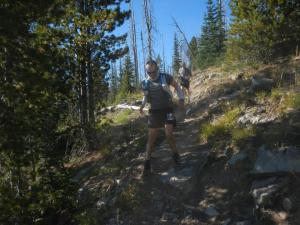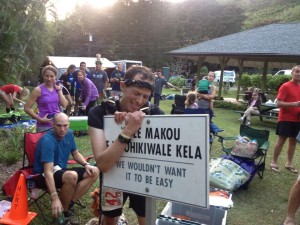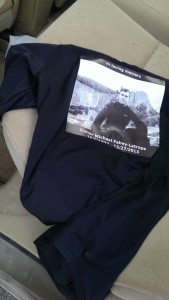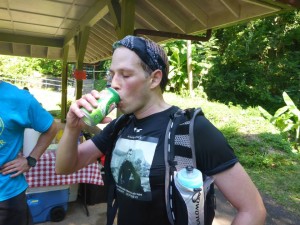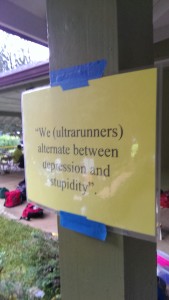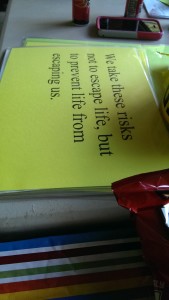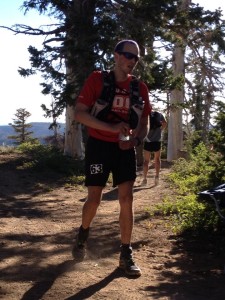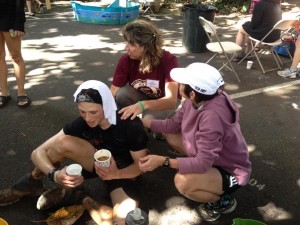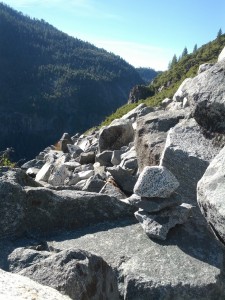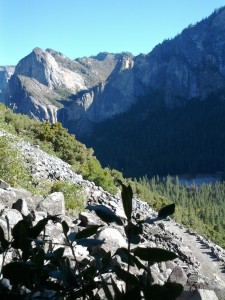I’m 150 miles into the Bigfoot 200 and, remarkably, the only problem I have with my feet is that some asshole keeps walking on them. Over and over. Hundreds of thousands of times. Surely he’ll stop sometime soon, right?
The good news is that I have a brand new pair of running shoes, a full size bigger than I normally wear, waiting for me at the next aid station. The bad news is I still have to climb 2500′ feet up Elk Peak and a little ways down the other side before I get there. The climb isn’t particularly tough, at least not by Bigfoot standards, but it is full of maddening false summits, and I’m beginning to run low on patience. I find myself composing a Least Favorite Mountains List, Unabridged:
1. Elk Peak
I’m running with Heather, and at this point we’re pretty sure we’re the last two runners in the field. She runs out of water before me, so I share my last few sips with her. As we near the summit we can hear booming thunder from what we think is the next ridge over, but we can’t see the flashes to tell how far away it is or if it’s moving our way. By the time we reach the short, steep out-and-back to the exposed peak, there are dark clouds above us, but still no more than a few drops of rain, so we decide to leave our trekking poles behind and go for it. The approach is steep enough that on the way back down I’ll be grabbing onto tree branches to slow myself.
At the summit we can tell the lightning is still at least one ridge over, and I know from looking at the elevation chart earlier the Klickitat aid station can’t be much more than a mile away, all downhill. Still, it’s steep enough that it’s hard to go as fast as I want, and I’m thirsty enough that I’m starting to wonder if today’s the day I’ll find out what it’s like to drink my own urine. That thought is just starting to transition from a joke to a worry when I round a switchback and shout up the trail to Heather, “I see it!” A moment later my friend Bull is shouting my name as I come down out of the forest.
There was a certain rhythm to the Bigfoot 200: as the race wore on, each new segment would start out with a major boost from the aid station before it, but halfway through it would become its own distinct, increasingly epic, challenge. Difficulties came in all kinds of ways, but they came without fail.
Mile 30 came after several hours trekking through the blast zone of Mount Saint Helens, boulder hopping through a lava-rock talus field, then traversing steep canyons of ash as I circumnavigated the volcano. After crossing a series of shallow ashy washes, I discovered I was coming into the aid station from the wrong direction. This meant backtracking a mile to the turn I’d somehow missed, then running another five miles to complete that leg of the course correctly. This mistake only added two miles or so, but made for a couple of discouraging hours.
There’s a famous quote from elite ultrarunner Karl Meltzer: “100 miles is not that far.” And of course that’s bullshit, pure macho swagger. You can’t run 100 miles without some suffering, some risk, and a ton of commitment. After even having attempted a 200, though, he’s right. When you run a 100, you wake up, you start running, and at some point, you’re done. When you run a 200, you wake up, you start running, days pass, things change both inside you and out, you stop running whether or not you want to, and at some point, maybe, it’s done with you.
I got 90 minutes of sleep at the Coldwater Lake aid station at mile 46, the only full REM cycle I’d hit in the race, and left in time to enjoy the sunrise as I climbed out of the basin. The whole second day would be marked with spectacular alpine views (and the occasional stretch of treacherous footing). The second night would be marked by a light cold rain, and while it didn’t last long it soaked the long grass that stretched across the next few miles of narrow, rutted trail, soaking me with every step. This was the first major low point as I chided myself for ditching the rain pants from my pack at the last minute and tried to remember if I’d packed a change of clothes at the next aid station, mile 90.
Fortunately I had, and once I’d changed and relaxed in front of a propane heater for a few minutes I felt much better. I asked a race volunteer to wake me up after 90 minutes and went over to the sleep station to lay down. Unfortunately, they confused me with another runner and woke me after 45 minutes, and I got up groggy and confused, rushing to get out of there. I only made it a mile down the trail before I realized I needed more sleep. I pulled out my phone, set an alarm for 20 minutes, and was out like a light, but awake again long before it went off. For the rest of the race, the only sleep I’d get would be like this, in five to fifteen minute bursts on the side of the trail.
On the ride up from Oakland, I asked Bull why he runs 200s. He said it’s because he learns so much about himself. This would be his sixth in a year. I guess there’s a lot to learn, but not all of those lessons are easy, and not all of them are good.
It was the afternoon of the third day when I hit the Lewis River trail, a gently rolling path that winds its way through shady waterfall views and roaming packs of families and college students, none of whom can seem to understand why someone wearing a race bib would be moving so slowly. I couldn’t understand why the aid station would be taking so long to appear. When it finally did, I learned that I only had nine and a half hours to make it 19 miles, and over a mile uphill, to Council Bluff. I refueled and took off running, hooking up with another runner named Reed for four miles of steep rolling trails. Finally I realized I was overheating and sat down to rest, insisting Reed go on alone.
I was able to cover the next 15 miles in just enough time, blazing into the aid station ten minutes under the cutoff, only to learn that it had been changed after I left Lewis River. This meant I had plenty of time to rest up before heading back out. I should have used more of it.
The next section, even though it was relatively short and easy, was where things got bad. Even though it was not where my race ended, it was where I hit bottom. It’s because of what happened on my way to Chain of Lakes that I’m not sure 200 mile mountain runs like this are really something people should do. My experience might not have been typical, but from talking to other runners about what happens after three nights of running, it wasn’t too unusual, or even as bad as things can get. I’m still shaken up just thinking about it.
Sometime after sunrise, I made the left turn off a flat gravel road onto a narrow trail that marked the last two miles to the aid station. My sense of time was shot, but I knew that I was moving painfully slowly, and that for some time I’d been seemingly uncontrollably making strange sounds, grunts and hoots, as I made my way. Worse, I’d been talking to myself in a strange, antagonistic way that I felt somewhat disconnected from. The words coming out of my mouth weren’t a surprise, but they weren’t intended, either.
When I finally came to a sign on the trail saying there was one mile left to the aid station, I knew I’d missed the cutoff. I didn’t pull out my phone to check the time, I hadn’t done so for hours, and I couldn’t tell how high the sun was through the tall trees, but I was moving so slowly I had to be. It was decided. It was a fact, as real as if I’d just been told by the race director herself.
First I broke down sobbing, gutted that I’d come so far and now my race was over because I was just too slow. Then, for lack of a better word, I threw a tantrum, wailing and tossing my trekking poles around, tearing plants out of the ground and smashing them, like a badly behaved five year old. My rational mind was gone, worn away by 71 hours of continual effort and sleep deprivation, and I don’t much like what was left behind.
When I finally got to the aid station, I just sat down without speaking or looking anyone in the eye. I found out I still had two hours before the cutoff and, after all I’d just put myself through, I felt devastated. That meant I’d have to keep going and, worse yet, I’d have plenty of time to make it to Klickitat, where I’d have to keep going again. But after sitting, eating, and being around company for a while, I felt much better, and I wouldn’t go back to such a dark place again.
Sometime around mile 100 I realized my quads were starting to bother me for the first time, and I congratulated myself on how well I was pacing myself. If I was right and my pacing was good, my training was off. In either case, I was too slow. You can’t run a 200 mile mountain race with a 108 hour cutoff at a two mile per hour average and hope to finish. I’ve done great at tough 100s like HURT pushing the cutoffs this way, but in a mountain 200, the odds of nothing big going wrong over the course of four and a half days are practically zero. I came so close I can still taste it, but with the strategy and conditioning I started the race with, maybe that was the best I could ever hope for.
It turned out the real crux of the race would come after my bonus miles, after my frigid pants-wetting, after my long dark sunrise of the soul, after my least favorite mountain. If you talk to anyone who ran the late miles of Bigfoot 200, they will tell you about the horrors of the Klickitat to Twin Sisters leg: 5,000 feet of climbing, much of it in hands-and-knees steep bursts, over 17 overgrown, undermarked miles. I got to do it at night, alone, exhausted. Normally I enjoy this sort of terrain, but even at the moments when I was energized from a nap it was such slow going that I started to despair of making the 4:30am cutoff at Twin Sisters, mile 175.
At 4:00am, I realized that, without having seen any of the major course landmarks, the aid station could be half a mile or five miles away. I sprinted off down the trail, fighting my way through brush along a ridgeline, up and down steep rollers, finally coming to a stop halfway up a 30% grade at 4:30am. I hadn’t made it. They might have changed this cutoff too, or they might decide to let me through anyway, but either way I’d been too slow. I sat down to rest, and woke up twenty minutes later with my ankle hurting like hell. The adrenaline was gone; here came reality.
It turned out I was about three miles from Twin Sisters at a formation called the Cispus when this happened. A volunteer named Jim who had been walking another runner out from the aid station to the junction help walk me in, which was good, because even using my trekking poles as crutches I was moving about half a mile an hour. He confirmed that they had removed the cutoff; if I hadn’t made that last push and hurt my foot, I could have made it past Twin Sisters to the last two relatively easy legs of the course and a nearly guaranteed finish. Unlike when I’d convinced myself my race was over the previous morning, now I just felt drained.
Even though things did not go as planned, and I have serious reservations about putting the human mind through such stresses, a huge part of me is sad it’s over. I didn’t need to finish this one to experience incredible highs or to see miles and miles – hell, days and days – of unforgettable views. I don’t know that I could honestly recommend that anyone take on a challenge like this. I’ll be digesting this one for a long time. I’m also pretty sure this won’t be my last.

